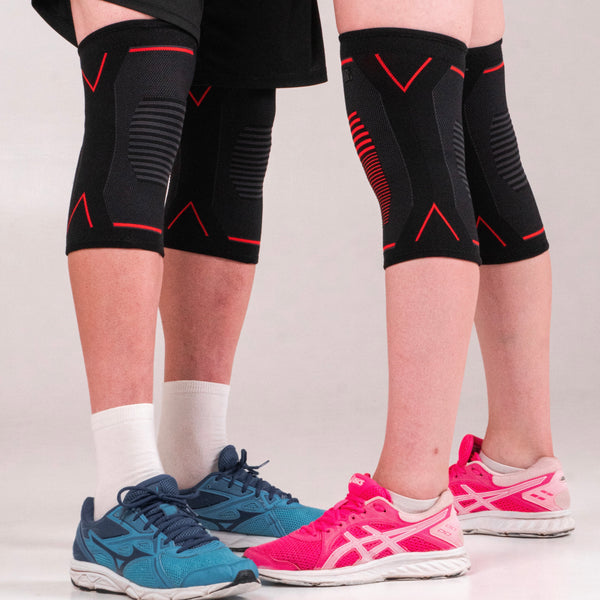Knee Pain Explained: Common Causes and How Braces Can Help
by Emily Jannet on Nov 03, 2023
Knee pain is a prevalent issue that affects people of all ages and backgrounds. Whether you're an athlete, a desk worker, or a retiree, chances are you've experienced some form of knee discomfort at one point in your life. It can be caused by a myriad of factors, from acute injuries to chronic conditions. In this comprehensive guide, we will explore the common causes of knee pain and how braces can be a valuable tool in alleviating discomfort, aiding recovery, and preventing further injuries.
Common Causes of Knee Pain
Understanding the causes of knee pain is crucial for effective management. There are numerous factors that can contribute to knee pain, and it's essential to identify the root cause to implement the right treatment or preventive measures.
Injuries
Acute Injuries: These injuries are usually the result of a sudden impact or trauma. Common acute knee injuries include sprains, strains, ligament tears (such as the anterior cruciate ligament or ACL), and meniscus tears. These injuries often lead to severe pain, swelling, and instability.
Overuse Injuries: Overuse injuries are more common among athletes, but they can affect anyone who repeatedly stresses their knees. Conditions like patellofemoral pain syndrome (runner's knee) and iliotibial (IT) band syndrome can result from overuse, causing chronic knee pain.
Arthritis
Osteoarthritis: This is the most common form of arthritis, often seen in older adults. It occurs when the protective cartilage that cushions the ends of the bones in the knee joint deteriorates over time, leading to pain and stiffness.
Rheumatoid Arthritis: An autoimmune disease that can affect the knee joint, leading to inflammation and pain.
Other Conditions
Bursitis: Inflammation of the bursae, small sacs of fluid that cushion the knee joint.
Tendinitis: Inflammation of the tendons, such as patellar tendinitis (jumper's knee), which commonly affects athletes.
Gout: A form of inflammatory arthritis that can cause sudden, severe knee pain.
Chondromalacia Patellae: Softening and damage to the cartilage on the underside of the kneecap, leading to pain.
How Knee Braces Can Help
Knee braces are valuable tools in the management of knee pain. They provide support, stability, and pain relief, depending on the type of brace and the condition it's designed to address.
Stability Braces
Hinged Braces: These are ideal for those recovering from ligament injuries, such as ACL tears. Hinged braces offer lateral support to prevent excessive movement, providing stability to the knee joint during the healing process.
Prophylactic Braces: Athletes often wear prophylactic braces to prevent injuries, particularly during contact sports. These braces offer protection against common knee injuries.
Compression Braces
Sleeve Braces: These provide compression to reduce swelling and offer pain relief, making them useful for conditions like arthritis and bursitis.
Elastic Bandages: While not technically braces, elastic bandages can be wrapped around the knee to provide compression and support. They are easily adjustable and offer flexibility for various knee issues.
Unloader Braces
Valgus and Varus Unloader Braces: Designed for individuals with osteoarthritis, these braces shift the load away from the affected part of the knee, reducing pain and improving joint function.
Patellar Stabilizing Braces
These braces provide focused support for the kneecap (patella) and are beneficial for conditions like patellofemoral pain syndrome.
Functional Braces
Often used after surgery, these braces provide support while allowing a range of motion. They are useful during the rehabilitation phase to help individuals regain strength and mobility.
Custom Braces
In some cases, a custom-made knee brace may be necessary. These are tailored to an individual's unique needs and often prescribed by a healthcare professional.

Benefits of Using Knee Braces
Knee braces offer various benefits, depending on the type of brace and the individual's condition. Here are some key advantages of using knee braces:
Pain Relief: Knee braces can help reduce pain and discomfort associated with various knee conditions by providing support and compression.
Stability: For those recovering from injuries or surgeries, knee braces can offer stability to prevent further damage and facilitate healing.
Prevention: Prophylactic braces can be used to prevent injuries, making them valuable for athletes and individuals at risk of knee issues.
Improved Function: Braces like unloader braces can improve joint function for those with osteoarthritis, allowing for increased mobility.
Reduced Swelling: Compression braces and bandages can help reduce swelling and inflammation, aiding the recovery process.
Enhanced Confidence: Knowing that your knee is supported and protected can boost your confidence and encourage physical activity and exercise.
Choosing the Right Knee Brace
Selecting the right knee brace is crucial for effective management of knee pain. It's advisable to consult a healthcare professional or orthopedic specialist to determine the most suitable brace for your specific condition. Consider the following factors when choosing a knee brace:
Type of Injury or Condition: The type of knee problem you have will dictate the type of brace you need. Make sure it's designed to address your specific issue.
Fit: A properly fitting brace is essential for its effectiveness. It should be snug but not too tight, and it should allow for comfortable movement.
Quality: Invest in a high-quality brace to ensure durability and proper support. Cheaper options may not provide the level of support required.
Adjustability: Some braces offer adjustable features to tailor the fit to your needs. This can be especially useful during the recovery process.
Consultation: Always consult a healthcare professional before purchasing a knee brace. They can provide recommendations and ensure it is the right choice for your condition.
Conclusion
Knee pain can be a significant hindrance to daily activities and overall quality of life. Fortunately, knee braces offer an effective solution for managing and alleviating this discomfort. By understanding the common causes of knee pain and the various types of braces available, individuals can make informed decisions about their treatment and prevention options.
Whether you're recovering from an injury, managing a chronic condition like arthritis, or looking to prevent knee issues, knee braces can be valuable tools in your journey to pain relief and improved knee health. However, it's essential to seek professional guidance to ensure you choose the right brace for your specific needs. With the right support, you can take steps toward a pain-free and active life.





